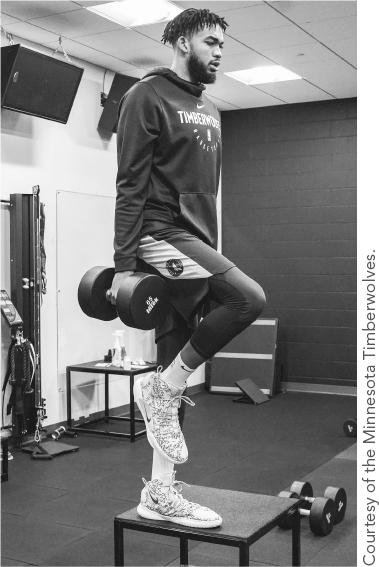Improve jumping, acceleration, and change-of-direction abilities
This is an excerpt from Strength Training for Basketball by Javair Gillett,William Burgos-Fontanez Jr.
By Bill Burgos
Explosive basketball athletes require optimal muscle elasticity. Reactive strength is reliant on eccentric force development, elastic energy storage and release, and muscle reflexive properties. Concentric force production is also correlated with the reactive strength index (4). Training to increase reactive strength involves the stretch-shortening cycle and, therefore, serves as another mode of resistance training. Performance in agility tests may also be related to reactive strength attributes. In another analysis, female athletes who exhibited faster agility times had shorter ground contact braking times when compared with slower athletes (59). The ability to move quickly around the basketball court is highly related to the athlete's ability to interact with the ground properly. Stronger athletes exhibit higher ground reaction forces. In many instances a basketball athlete must stop very quickly and move in another direction. Other times, a center will jump vertically to rebound a ball that bounces around the rim. The delay will require the athlete to land and quickly jump up a second time. People with superior lower body strength have higher peak power output during jumping activities (10). As a result, the stronger athlete will be able to minimize ground contact time while still being able to reach near maximal jump height in
the second jump.
Over the total distance covered in a game, a basketball athlete can experience various movement demands that place a tremendous amount of mechanical stress on the body. To grasp the importance of resistance training for the basketball athlete, a coach must understand that performance attributes like agility, power, and speed rely heavily on strength. The neuromuscular adaptations brought on by mechanical stress will be specific to the manipulation of several resistance training variables such as load, sets, repetitions, tempo, and rest period length.
Each quality of strength is unique and plays a role in injury prevention and reaching optimal physical performance. Change of direction involves multiple components of strength including eccentric (braking), isometric (planting), and concentric (propulsive) phases (59). Movements such as jumping and cutting rely on the ability to absorb the forces effectively in order to redirect those forces and produce maximal concentric power. Therefore, the ability to decelerate and reaccelerate quickly is related to eccentric strength. Accentuated eccentric overload training appears to improve muscle architecture, strength, power, and velocity more than traditional resistance training does (12, 30). As a result, eccentric training should also play an integral role in a basketball athlete's resistance training program.

Resistance training improves a basketball athlete's ability to jump, accelerate, and change directions in the face of an opponent.
The stretch-shortening cycle plays an important role in countermovement activities. Stronger muscles are able to contract and store elastic energy better than weaker muscles. Elastic energy, which is stored in the muscle-tendon unit, is created in the eccentric phase. Naturally, this form of stored energy can be transferred into the concentric, acceleration phase. The greater an athlete's ability to transfer this energy, during what is called the amortization phase, the greater her or his ability will be to perform explosive countermovement activities. For example, Bridgeman and colleagues (7) showed that lower body eccentric strength is highly related to overall jump performance. Resistance training increases eccentric strength, and combining eccentric resistance training with traditional, concentrically focused training modes can have positive effects on jump performance (41). Furthermore, although type II fibers may be recruited regardless of load when sets are performed to failure, heavy loads require type II fiber recruitment. In addition, heavy loads appear to be more effective for eliciting neural adaptations that, in turn, facilitate strength improvements (31, 45, 36). Therefore, heavy or explosive resistance training may be an effective means by which to augment power production during the countermovement activities encountered in basketball.
Muscle architecture influences the athlete's ability to move explosively. When looking at dynamic movements such as the countermovement jump, jump height, peak force, and peak velocity are all related to greater vastus lateralis thickness and gastrocnemius pennation angle (32). In general, resistance training improves muscle thickness, pennation angle, and fascicle length (12, 32). Regardless of training goals, an important goal is to bridge the gap between injury prevention and reaching optimal performance. Carefully designed resistance training programs performed in combination with ballistic, high-velocity basketball-specific movements may optimize muscle geometry and enhance performance in a dynamic, explosive sport such as basketball.
More Excerpts From Strength Training for BasketballSHOP

Get the latest insights with regular newsletters, plus periodic product information and special insider offers.
JOIN NOW


